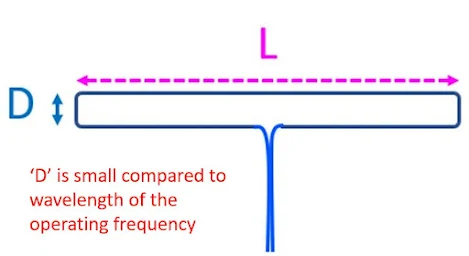Folded Dipole With Coax Balun
Folded dipole can be considered as a dipole antenna on top of which a loop of conductor is added so that it will be short circuiting any direct current fed to the antenna, though antennas are typically fed with alternating currents. Folded dipole is a balanced antenna and has to be fed by balanced feeder like a twin lead ladder line. If a coaxial cable is used to feed the folded dipole antenna, a balun or balanced to unbalanced transformer has to be used. While the usual half-wave dipole antenna has an impedance of about 70 Ohms, folded dipole antenna has an impedance of around 280 Ohms. So it matches well with a ladder line of 300 Ohms impedance. Earlier twin lead ribbon tapes were used to connect the folded dipole television antenna to the television receiver. Folded dipole antenna has a higher bandwidth than the usual half-wave dipole antenna.
Coax balun is a simple way for eliminating feedline radiation which would occur if dipole is fed by a coaxial cable without a balun at the feedpoint. Bandwidth of a coax balun is low, still it can be considered for narrow amateur radio bands or if you want to operate only in a narrow set of operating frequencies. While calculating the length of coax for half wavelength of coax to be used, velocity factor has to be considered. In the diagram, the half wavelength of coax balun is kept folded in a U shaped manner, near the feedpoint. Shields of both ends of the coax balun and that of the feedline are connected together. Inner conductor of one end of the coax balun is connected to the inner conductor of the feedline and to one end of the folded dipole as shown. Inner conductor of the other end of the coax balun is connected to the other end of the folded dipole.
As the two conductors are near each other, the folded dipole is considered like a single conductor of half wavelength and has a directivity similar to half-wave dipole. The distance between the conductors is small compared to the wavelength of the operating frequency. Half-wave folded dipole is commonly used as the driven element of a Yagi multi-element antenna. Like a half-wave dipole antenna, the folded dipole is also resonant and radiates well at odd integer multiples of half-wave lengths. As mentioned in case of half-wave dipole antenna, it acts as a 3/2 wavelength dipole at three times the fundamental frequency. Folded half-wave dipole antenna is preferred when the impedance has to be higher.
If multiple folded dipoles are arranged vertically as seen in the image, it is called a collinear antenna array. Such an array has an omnidirectional radiation pattern in the horizontal plane. These can be implemented in VHF and UHF bands as the wavelengths are small enough to have several folded dipoles stacked on a mast. Wasting of RF energy by radiation to the sky above and Earth below are avoided by such a collinear array and is useful for terrestrial communication. Four collinear half wave dipoles have a gain of 6 dB over a single dipole. As the gain of a single dipole compared to an isotropic antenna is 2.15 dBi, the total gain of a four element collinear array is 8.15 dBi. The collinear dipoles have to be fed in phase.

Comments
Post a Comment